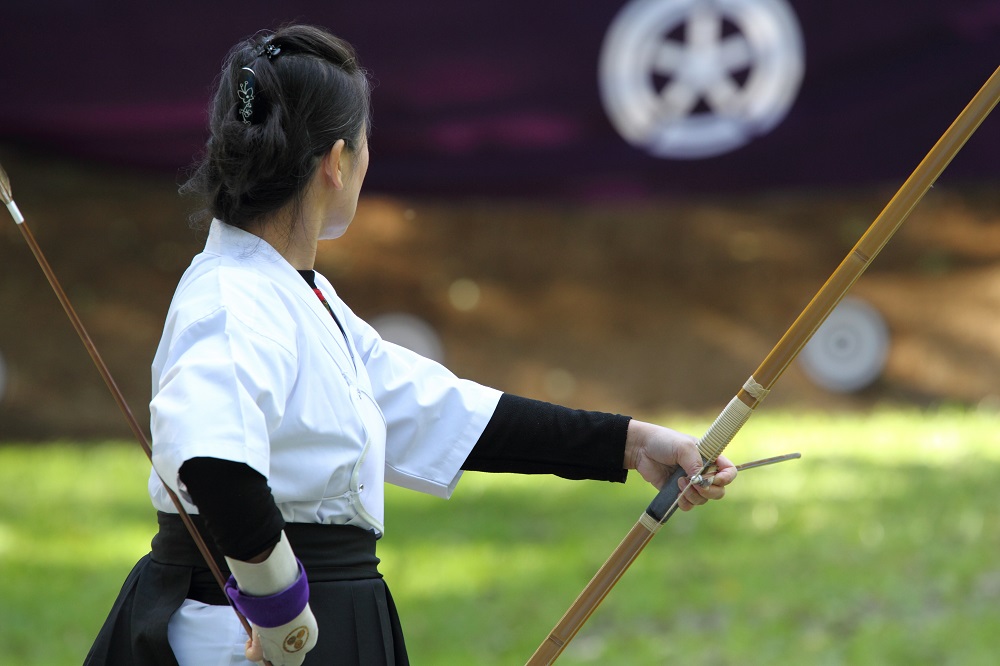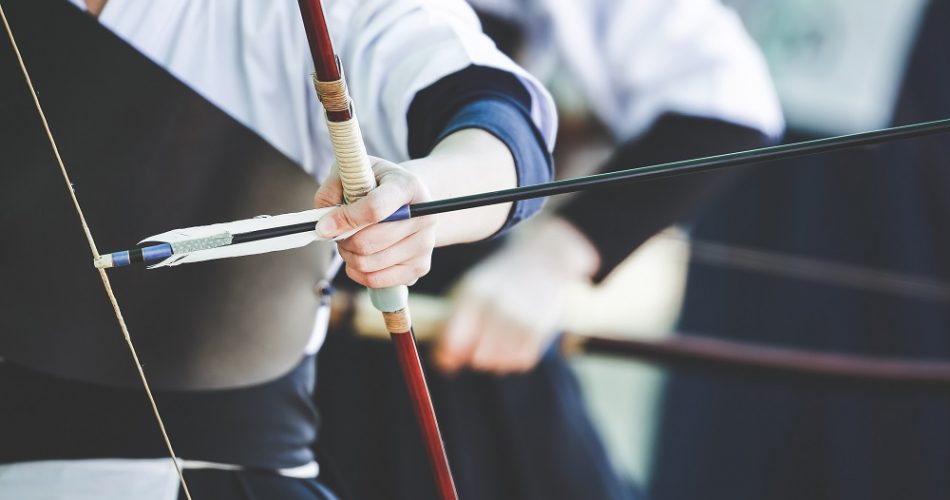During my one-year Japanese language and culture exchange study in Kyoto University of Education, I decided to join the kyūdō club 弓道部-Traditional Japanese martial art of archery.
Before joining the club, I knew almost nothing about Kyūdō – I’ve only heard that it is pretty different from Western style archery, and I’ve seen photos of my friend, who also practiced Kyūdō during her study in Japan . Of course, when I saw the photos, I thought that it’s amazing: hakama style 袴 looks traditional and beautiful. When I first arrived in the Dojo道場, I was amazed by the atmosphere – everyone was so concentrated and looked very cool in hakama. But after the practice all the members came to speak to me and they were very nice. I decided to join from the next practice.To be part of the club was really an honour and seemed like a dream – I will also wear hakama, holding the bow (弓) in one hand, the arrow(矢) in the other and always hitting straight in the middle of the target!

Kyūdō practices, that I attended were around 3-4 hours long, at first members cleaned the Dōjō,when all members gather started the Rei (courtesy, mutual respect and propriety) ceremony, during which, all members were reading the moto of the club, followed by the Sharei (ceremonial shooting, performed by seniors)and after that all members, including newcomers, could proceed to their own practice. One of the main rules was that while practicing and holding the bow you must take your coat off. In winter the Dōjō was getting very cold, especially in the evenings when there was no sun and the time, when newcomers can practice in the Dōjō was only at the end of the practice- usually around 7-8 at the evening.
To be honest, for almost 8 months of practice (because of the class schedule I could go only once a week) I shot in the main Dōjō (where the distance to the target is about 20m) only twice, and couldn’t even get close to the target…

But, for this 8 months I learned other important things:
1 To shout あーたーりー (Atari– “In the target”) when a seniors (先輩Sempai)hits the target
2 To pick up the arrows from the targets, after Sempai’s shot
3. The eight most important poses and movements for shooting – 射法八節 (Shyahōhassetsu), which we, the newcomers (新入部員) were practicing every time in a separate small Dōjō, in front of straw targets makiwara(巻き藁), while Sempai were practicing in the Dōjō.
4 That it is not allowed to bring sweets on tournaments!
On the first University Kyudo Tournament that we attended in Nara I decided to bring a package of cookies in order to share them with other members during the lunch break. When Sempai members saw the cookies they seemed shocked and asked me to put them back in my bag, before someone sees – since it looks like you came to a party、not to a serious tournament.
5 Hitting the target is far from the main purposes of practicing Kyūdō
Back then, I couldn’t understand many things about Kyūdō, most of them related to the club tradition 部活 in general : why going to practice can be considered more important for the students than attending classes, why they are giving their best to organize the so-called コンパcompa – events for socializing with former club seniours (O.B. and O.G.), which were even harder than the usual practice. Later I understood that attending a club, especially traditional martial art club, can be considered as a preparation for the life in society after graduating university – putting efforts in club activities is an important point in job-hunting interviews, organizing and attending compa was similar to the meetings with clients or superiors nomikai 飲み会, which are often one of the obligations of company employees.
And the patience that is needed in bukatsu, as well as in society.
For my 8 months in Kyūdō but I didn’t manage to become a cool European-Japanese version of Mulan, as I probably imagined in the beginning, could not get even closer.
But there is one episode from my Kyūdō experience, that I think will always remember.
One December night during the practice in Dōjō, when it was so cold, that my feet and hands were freezing and I just couldn’t stop the tears falling down my face a Sempai was watching my posture and shooting. I was holding the bow and arrow, so I couldn’t wear a coat, but this was the only time when Sempais could – because they’ve already finished their shooting. When Sempai saw me crying, he took his coat off. He couldn’t let me put on an outer during the practice, since it was a general rule, but he decided to share my suffering
I can’t say that I got warmer at that moment, but that was definitely one of the biggest encounters with Japanese culture for me.
Now, when I think about the time I spent in the Kyudo club I realize that it was a great opportunity to learn a lot about Japan’s culture and society and I am really grateful for it.



Comments